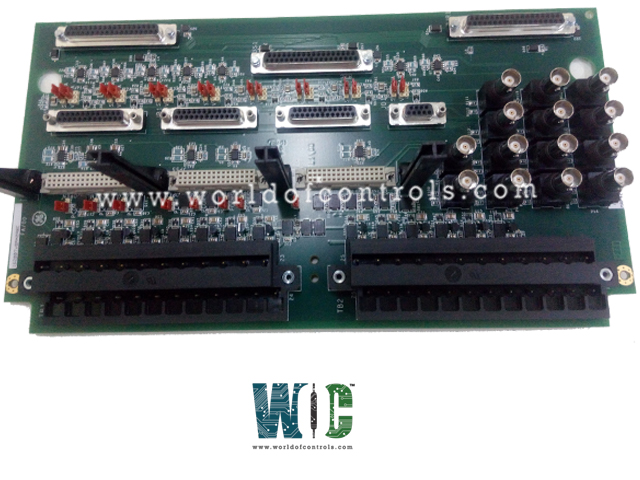
World Of Controls understands the criticality of your requirement and works towards reducing the lead time as much as possible.
IS200TVBAS1A - Vibration Terminal Board is available in stock which ships the same day.
IS200TVBAS1A - Vibration Terminal Board comes in UNUSED as well as REBUILT condition.
To avail our best deals for IS200TVBAS1A - Vibration Terminal Board, contact us and we will get back to you within 24 hours.
SPECIFICATIONS:
Part Number: IS200TVBAS1A
Manufacturer: General Electric
Series: Mark VIe
Product Type: Vibration Terminal Board
Number of channels supporting vibration probes: 8
Number of channels with selectable pull: 8
Number of channels with PRxxL: 8
MPU pulse rate range: 2 Hz to 20 kHz
Voltage Range: 18 - 32 VDC
Number of buffered outputs: 14
Mounting: DIN-rail mounting
Amplitude accuracy: ± 0.1%
Technology: Surface mount
Number of N24 outputs: 14
N24 maximum current: 12 mA
Operating temperature: -30 to 65°C
N28 voltage: 28 normal
N28 maximum current: 400 mA
Size: Size 33.0 cm high x 17.8 cm
Repair: 3-7 Day
Availability: In Stock
Country of Origin: United States
Manual: GEH-6721D
FUNCTIONAL DESCRIPTION:
IS200TVBAS1A is a Vibration Terminal Board manufactured and designed by General Electric as part of the Mark VIe Series used in GE Distributed Turbine Control Systems. The vibration terminal board (TVBA) acts as a signal interface board for the Mark VIe I/O pack PVIB. In the Mark VI system, the VVIB board works with TVIB. The TVBA provides a direct interface to seismic (velocity), Proximitors, Velomitors, and accelerometer-type probes. The terminal board provides signal suppression and electromagnetic interface (EMI) protection for each input signal. Signals are also connected to a pull-up bias to allow open circuit detection. The signals are passed on to the Mark VIe I/O packs through a 37-pin connector. The TVBA can be used for either simplex or TMR applications.
TMR applications fan the signal to three I/O packs. The TVBA contains buffered outputs to additional connectors beyond the standard 37-pin connection. This feature allows, special 9 and 25-pin connectors to feed the Bently Nevada® 3500 monitoring system. A bayonet nut connection (BNC) connection for each channel is also included with this feature, to feed other third-party monitoring equipment. Mark VIe systems do not use the traditional RKPS power supply. Power is obtained from sourced +28V power supplies and there is no external source for -28V. The TVBA must maintain the same functionality as the Mark VI TVIB. For this reason, the TVBA will have three removable daughterboards to convert +28 to -28. These boards, WNPS (negative power supply) will be the source for all negative power used by the TVBA.
INSTALLATION:
The TVBA accepts 14 sensor inputs that are wired directly to two I/O terminal blocks. Each block is held down with two screws and has 24 terminals accepting up to #12 AWG wires. A shield termination attachment point is located adjacent to each terminal block.
Input Channels 1 through 8:
Input Channels 9 through 12:
Input Channel 13:
-28V power supply board, WNPS:
CONFIGURATION:
Jumper settings for TVBA as follows:
Jumpers J1A through J8A:
Jumpers J1B through J8B:
Jumpers J1C through J8C:
WOC has the largest stock of OEM Replacement Parts for GE Distributed Control Systems. We can also repair your faulty boards and supply unused and rebuilt boards backed up with a warranty. Our team of experts is available round the clock to support your OEM needs. Our team of experts at WOC is happy to assist you with any of your automation requirements. For pricing and availability on any parts and repairs, kindly contact our team by phone or email.
Why is a vibration terminal board important?
A vibration terminal board is crucial because it ensures reliable and accurate signal transmission from the vibration sensors to the monitoring system. It helps in reducing noise, providing proper grounding, and simplifying wiring, which enhances the overall performance and reliability of the vibration monitoring system.
What types of sensors can be connected to a vibration terminal board?
Vibration terminal boards can typically accommodate various types of sensors, including accelerometers, velocity sensors, and displacement sensors. The specific compatibility depends on the design and specifications of the terminal board.
How do you install a vibration terminal board?
Installation involves mounting the terminal board in a suitable enclosure or control panel, connecting the vibration sensors to the board using appropriate wiring, and then connecting the output from the board to the data acquisition system.